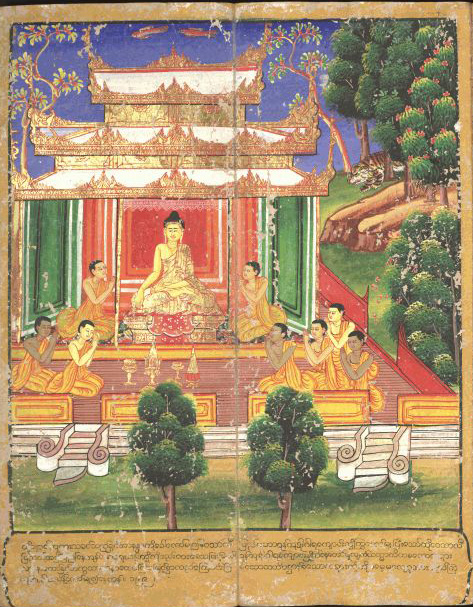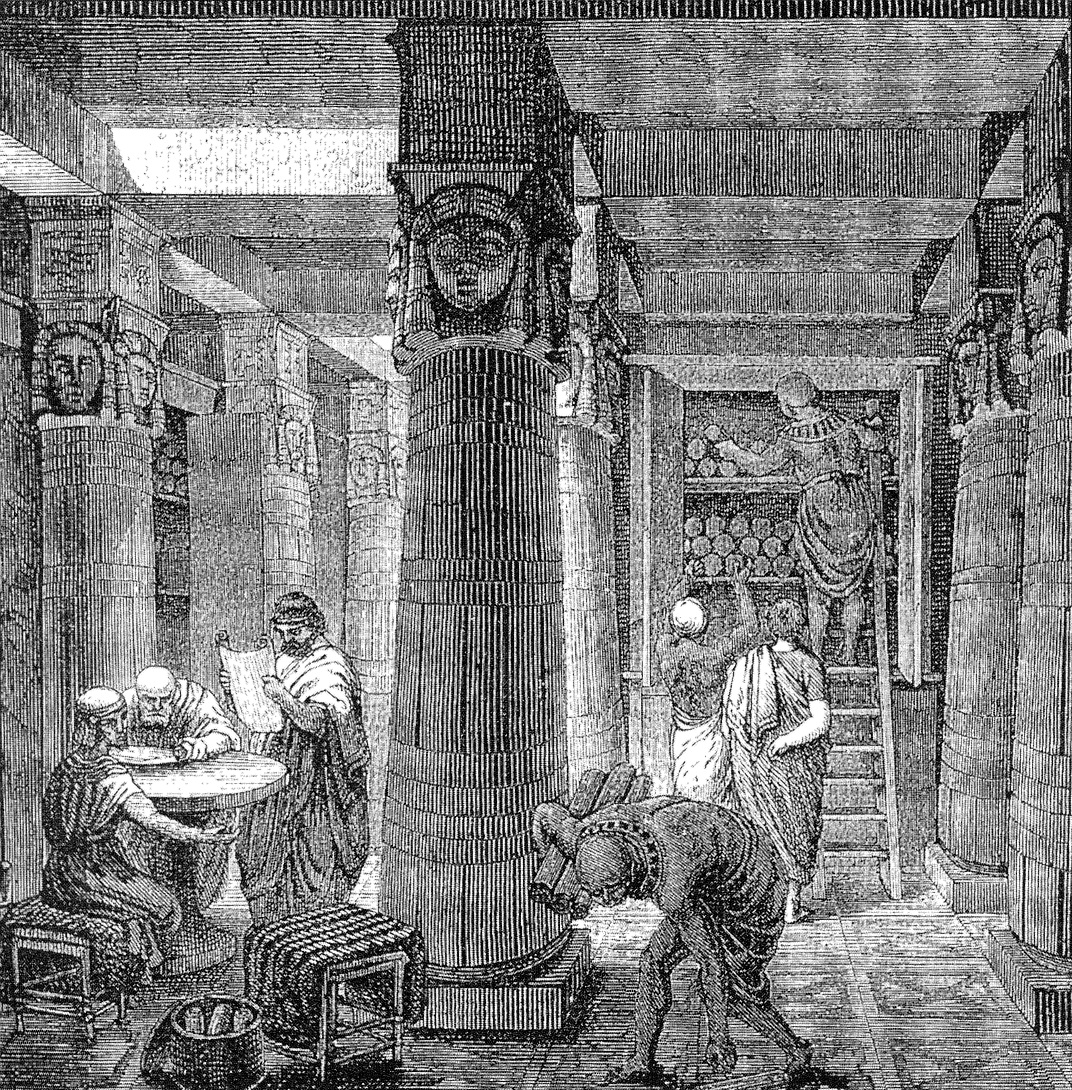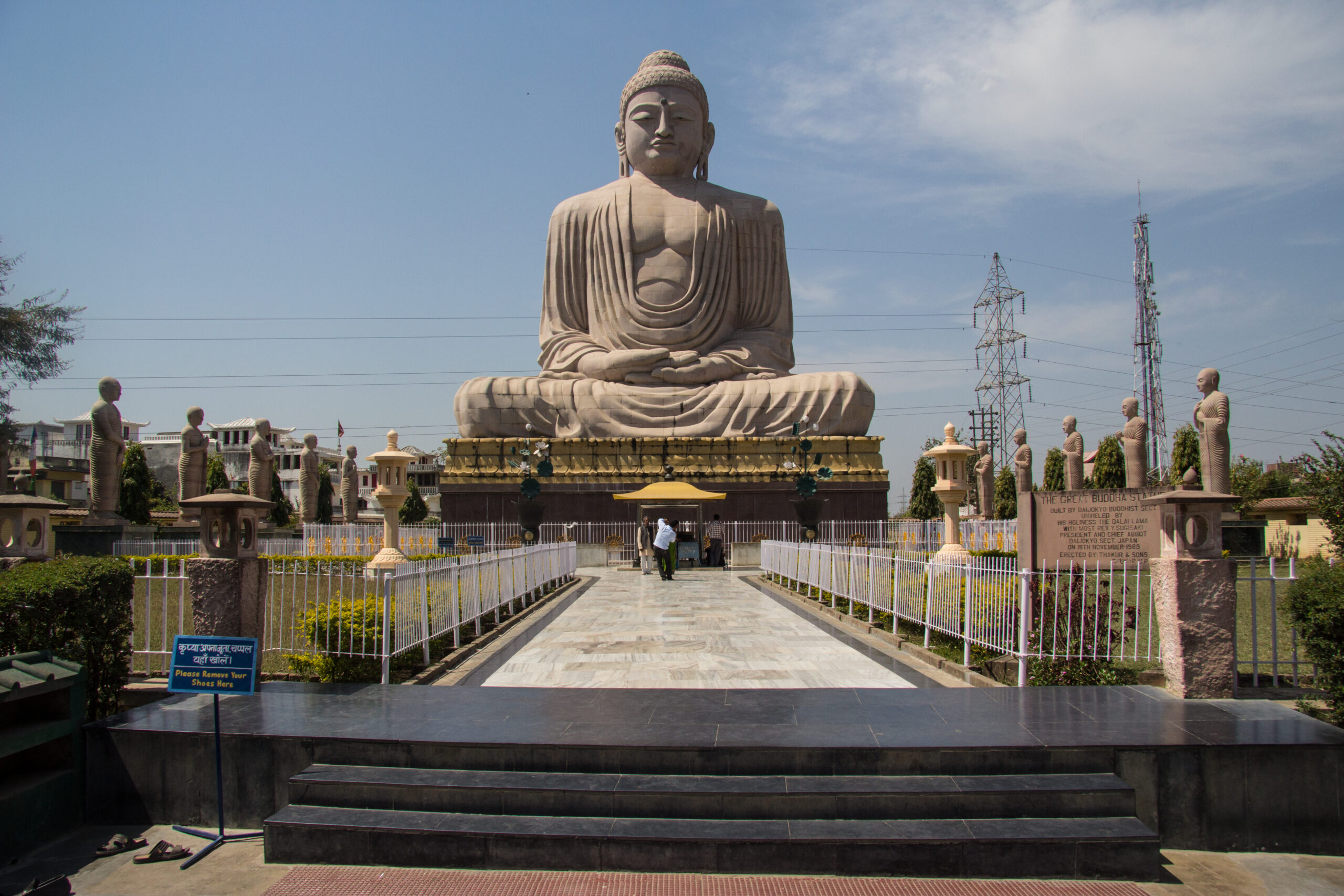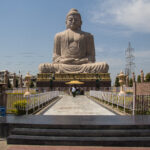Buddhist Philosophy Part II: Impermanence, Suffering and the Illusion of Self
The Four Noble Truths and the Noble Eightfold Path, the so-called Middle Way, for which Buddhism is perhaps most known for represent the very basic tenets of Buddhism in all its forms. Within this philosophical framework are included not only a unique perspective on the nature of reality itself which distinguish it from all other theo-philosophical traditions in antiquity, and in modern times, but also the basic guiding principles upon which a good and fulfilling life, and ultimately liberation and “enlightenment”, i.e. nirvana, or the cessation of suffering, can be achieved.
These core Buddhist tenets are primarily understood through a set of sutras referred to as the Dharmacakrapravartanasūtram, or as it is sometimes translated, The Setting in Motion of the Wheel of Dharma. These teachings can be found in the Sutra Pitaka, a section of Pali Canon which is believed to represent the earliest and most authoritative text of Buddhist philosophy. This teaching, akin to Jesus’s sermon on the mount, is was said to be delivered to five ascetic monks (bhikkhus) with whom he had practiced austerities with after he had renounced his royal heritage and who became his first followers.
As the story is told, upon approaching his former ascetic brethren, given that they recognized that he was no longer following their extreme ascetic ways being that he was fully clothed and well fed, his former friends were at first reluctant to receive him. However, after seeing him come closer, it was clear that he was a changed man, an enlightened and illumined being of sorts, and henceforth the monks sat and eagerly received his teachings.
Then the Realized One [Tathāgato], monks, in the first watch of the night agreed (to teach) by keeping silent, in the middle watch of the night he took delight in what was to be said, in the last watch of the night he addressed the auspicious group-of-five, (saying):
“There are these two extremes, monks, that one who has gone forth ought not to descend to, which is this: being joined and clinging to the pleasure in sense pleasures, which is low, vulgar, worldly, not very noble, not connected with the goal, not (helpful) for the spiritual life in the future, not leading to world-weariness, dispassion, cessation, deep knowledge, Complete Awakening, and Emancipation [Nirvana]; and this, which is not the middle practice: devotion to self-mortification, which is painful, not connected with the goal, painful in this very life and in the future where it results in pain.
Not having approached either of these two extremes, monks, the Doctrine of the middle practice [Middle Way] is being taught by the Realized One, which is this: right view, right thought, right speech, right action, right livelihood, right endeavor, right mindfulness, right concentration.
There are these Four Noble Truths, monks. Which four? Suffering, the arising of suffering, the cessation of suffering, and the practice leading to the cessation of suffering.
Herein, what is suffering? Birth is suffering also old age is suffering also sickness is suffering also death, being joined to what is not dear, being separated from what is dear, is suffering also not to obtain what one seeks for is suffering in brief. The five constituent parts (of mind and body) that provide fuel for attachment are suffering. This is said to be suffering.
Herein, what is the arising of suffering? it is that craving which leads to continuation in existence, which is connected with enjoyment and passion. This is said to be the arising of suffering.
Herein, what is the cessation of suffering? It is the complete fading away and cessation without remainder of the birth of that craving, which greatly enjoys this and that, and is connected with enjoyment and passion. This is [said to be] the cessation of suffering.
Herein, what is the practice leading to the cessation of suffering? It is the noble eightfold path [Noble Eightfold Path], which is this:
- right view [samyag-dṛṣṭiḥ],
- right thought [samyak-saṁkalpaḥ],
- right speech [samyag-vākright],
- right action [samyak-karmāntaḥ],
- right livelihood [samyag-ājīvaḥ],
- right endeavor [samyag-vyāyāmaḥ],
- right mindfulness [samyak-smṛtiḥ],
- right concentration [samyak-samādhir-iti].[1]
What we find here first and foremost in the initial part of his teaching is the fundamental belief that the basic problem of life, the one essential aspect of being to which all mankind is afflicted, is suffering. Furthermore, he outlines from the very start that his “revelation”, was not just that the nature of being or existence itself was essentially characterized by this notion of suffering (duḥkha in Sanskrit, or dukkha in Pali)[2], but that in fact he had “discovered” the source of this suffering, as well the specific practices and principles by which it could ultimately be eliminated, i.e. what he called the “cessation of suffering”. These principles and this path, again the so-called “Middle Way”, are referred to as the Four Noble Truths and the Noble Eightfold Path.
While The Four Noble Truths and Eightfold Noble Path represent the cornerstones of Buddha’s teachings, he also lays out a fairly sophisticated metaphysical framework upon which the intellectual foundations of his philosophy rests. Herein lies the philosophic portion of Buddhism, where he defines what he believes to be the true nature of “reality”, the fundamental characteristic of “being” and “existence” itself, which when properly understood, hold the key to the liberation from what is sometimes called the “wheel of dharma”.
At its core, Buddhist philosophy is based upon the notion that it is from a very basic and fundamental misconception and misunderstanding of the true nature of reality which is the cause, or source, of suffering in all its forms. It is fair to say then that Buddha’s teaching is based upon a fully rational and logical system of cause and effect, marking a stark departure – at least from his point of view – from the faith based theo-philosophical systems which dominated the intellectual landscape in the Indian subcontinent in the middle of the first millennium BCE and placing his teachings squarely within the philosophical intellectual revolution that sprung forth throughout Eurasian antiquity at that time – parallel to the Hellenic philosophical tradition to the West and the ancient Chinese philosophical tradition to the East.
The source of suffering according to Buddha’s teachings as interpreted and understood by his followers is based upon three basic “misconceptions”, or falsehoods, upon which he not only establishes his “worldview”, but also provide the rational foundation of his Four Noble Truths and in turn the Noble Eightfold Path, the basic practices and principles to be followed to end suffering once and for all. These misconceptions are referred to in the Buddhist tradition as the “three marks of existence”, or tilakkhaṇa in Pali (trilakṣaṇa in Sanskrit). They are:
- anicca(anitya in Sanskrit), typically translated as “Impermanence”[3],
- dukkhain Pali, duḥkha in Sanskrit, which is typically translated as “suffering” but a more literal translation might be “unsatisfactoriness”, and
- anattā, anātman in Sanskrit, which means literally “non-self”, or more literally translated as the “lack of existence of self”, or perhaps more aptly put as the “illusion” of self.[4]
It is from these three fundamental “misconceptions” from which our experience of suffering originates according to Buddha, and upon which the intellectual foundations of his Middle Path are based.
From the Khuddaka Nikāya, or “Minor Collection”, section of the Sutta Pitaka called the Dhammapada[5], or “Way of Dharma”, one of the cornerstone texts in all of Buddhist scripture, we find the following description of these “three marks of existence” as they relate to the Noble Eightfold Path and Four Noble Truths:
Of all the paths the Eightfold Path is the best; of all the truths the Four Noble Truths are the best; of all things passionlessness is the best: of men the Seeing One (the Buddha) is the best.
This is the only path; there is none other for the purification of insight. Tread this path, and you will bewilder Mara.
Walking upon this path you will make an end of suffering. Having discovered how to pull out the thorn of lust, I make known the path.
You yourselves must strive; the Buddhas only point the way. Those meditative ones who tread the path are released from the bonds of Mara.
“All conditioned things are impermanent” — when one sees this with wisdom, one turns away from suffering. This is the path to purification.
“All conditioned things are unsatisfactory” — when one sees this with wisdom, one turns away from suffering. This is the path to purification.
“All things are not-self” — when one sees this with wisdom, one turns away from suffering. This is the path to purification.
The idler who does not exert himself when he should, who though young and strong is full of sloth, with a mind full of vain thoughts — such an indolent man does not find the path to wisdom.
Let a man be watchful of speech, well controlled in mind, and not commit evil in bodily action. Let him purify these three courses of action, and win the path made known by the Great Sage.
Wisdom springs from meditation; without meditation wisdom wanes. Having known these two paths of progress and decline, let a man so conduct himself that his wisdom may increase.[6]
The passage above come from the chapter called “Magga Vagga”, or “Maggavagga”, typically translated as “The Way” or “Path”, and while it most likely represents a compilation of sayings and teachings of Buddha that were only later organized under a single heading or chapter, it still nonetheless philosophically connects the Eightfold Noble Path, the Four Noble Truths, and the tilakkhaṇa, i.e. the “three marks of existence”, arguably the three most distinctive characteristics of Buddhist philosophy.
Here, anicca (change or impermanence), dukkha (unsatisfactoriness), and anattā (no-self) are described as points of contemplation which lead one along the “path of purification”, providing the rational basis as it were of the Four Noble Truths. That is to say, it is the confusion surrounding the notion of the existence of Self (in particular as it was understood in Vedic philosophy), the illusion of any sort of permanent existence, and the recognition that anything that is “conditioned” or “qualified” in any way can only ultimately lead to a lack of satisfaction at some level, that form the backbone of ignorance from which the basic problem of human suffering originates from. So these three elementary characteristics of “reality”, or again “being”, are presented as being necessary and critical to the “purification” process which underlies the means by which cessation of suffering can be achieved. It’s important to note that the intellectual system is entirely rational, and in this sense it not only marks a significant departure from the theo-philosophical systems that preceded it in the Indian subcontinent, but it also places Buddhism squarely within the context of “philosophy”, particularly as it was understood in classical antiquity as reflected of Logos over Mythos, rather than “religion” as it is most often times viewed.
These three complementary and interrelated “marks of existence” permeate Buddhist philosophy and reflect the fact that according to Buddha’s teaching, it is ignorance, or lack of knowledge, that is the source of basic predicament of man, and conversely that “knowledge”, or the absence of ignorance, is the source of liberation, enlightenment or nirvana. These elemental, and primarily psychic, “marks of existence” therefore constitute the intellectual basis upon which the Four Noble Truths are constructed, and through which as explained in this passage above, the bonds of “Mara”, the deity that personified desire and death which the Buddha directly encountered and overcame on his journey toward enlightenment, can be broken.
Impermanence is the cornerstone of these three principles really, as it is the common thread under which all three “illusions” or “misconceptions” can be understood. It is mankind’s lack of recognition of the true nature of impermanence, as it relates to existence itself, which represents the fundamental ignorance, again the lack of knowledge, which is at the very root of the of the problem of human suffering according to Buddha. It is the very core of the intellectual problem as it were, a problem which rests on the principles of reason and causality, and therefore represents the “thorn” which must be removed in order that this “chain of causality” which underlies the problem of suffering can be broken. Impermanence then, is the basic metaphysical and philosophical tenet upon which all Buddhist philosophy fundamentally rests, the contemplation and full realization of which – again knowledge or lack of ignorance surrounding the true nature of – becomes the essential component of the attainment of nirvana.
From the Samyutta Nikaya portion of the Sutra Pitaka , we find further explanation of this notion of impermanence, anicca, and how it is directly associated to the principle of “non-self”, anattā.
The perceiving of impermanence, bhikkhus [monks], developed and frequently practiced, removes all sensual passion, removes all passion for material existence, removes all passion for becoming, removes all ignorance, removes and abolishes all conceit of “I am.”
Just as in the autumn a farmer, plowing with a large plow, cuts through all the spreading rootlets as he plows; in the same way, bhikkhus, the perceiving of impermanence, developed and frequently practiced, removes all sensual passion… removes and abolishes all conceit of “I am.” — SN 22.102[7]
The direct causal relationship between impermanence (anicca) and “suffering” (dukkha) is described as being caused by this illusion of self, this notion that “I am”, or that “I exist”, something that Buddha clearly saw as not only flawed, but totally based upon falsehoods and misconceptions surrounding the nature of reality. But in this sense Buddha’s teaching is not all that revolutionary. The idea that a misconception of the idea of self, or soul, or confusion surrounding the nature of existence was at the very heart of the philosophical revolution throughout the classical period of Eurasian antiquity. But this intellectual connection between these misconceptions, and the full acceptance of the rule of cause and effect in not just the domain of philosophy but also theology, or metaphysics, is surely one of the very unique and lasting contributions of Buddhist philosophy. Suffering then, is directly causally linked to impermanence itself, and once this is established and truly understood, it then becomes possible to eradicate it entirely.
“The body, bhikkhus [monks], is impermanent. What is impermanent, that is suffering. What is suffering, that is not-self. What is not-self [should be considered as] ‘This is not mine,’ ‘I am not this,’ ‘This is not myself’: in this manner it should be seen according to actuality with perfect wisdom.
“Feeling is impermanent… Perception… Mental activities… Consciousness is impermanent. What is impermanent, that is suffering. What is suffering, that is not-self. What is not-self, should be considered, ‘This is not mine,’ ‘I am not this,’ ‘This is not myself’: in this manner it should be seen according to actuality with perfect wisdom.” — SN 22.15[8]
Here, impermanence and suffering are not only “causally” equated, but the attainment of perfect wisdom, the end goal of Buddhist philosophy from which one can liberate themselves from suffering, is described as the practice of, and full and complete recognition and understanding of, the lack of existence of this notion of “self”, i.e. anattā. It is this notion of “not-self” – in Sanskrit anatman – which in fact represents the major philosophical departure from the prevailing philosophical doctrines of the Vedic schools of philosophy which rest squarely not only on the existence of “self”, or atman, but also its indivisibility and ultimate unity with the cosmic Self, or Brahman, the existence of which Buddha also denies. So impermanence and confusion regarding the idea of one’s one existence, become the cornerstone elements of Buddhist philosophy, ideas which are born out of the Vedic philosophical tradition from which Buddha is exposed during his journeying and wandering days, but which represent an almost complete inversion of the system itself, a system which is based upon reason, logic and causality rather than ritual, scripture or blind faith.
The important and relevant rational and logical deduction here however with respect to the Buddhist doctrine of impermanence and its relationship to suffering, and in turn the existence of a path or way by which suffering can be eliminated, is that this idea of self-existence itself is fundamentally flawed, hence the importance of the notion of “not-self”, anattā, in the Buddhist philosophical tradition, which when fully comprehended and “realized”, can form the intellectual basis upon which suffering itself can be completely, utterly, entirely and absolutely eliminated. This belief system depends upon two assumptions of course, a) that the basic problem of existence is not god realization or the attainment of heaven after death or even immortality but the avoidance of suffering, and b) that reality itself is not only fully “rational”, but that it also rests entirely upon metaphysical and ideological principles, i.e. our reality is governed by our minds and beliefs.
[1] From Dharmacakrapravartanasūtram, The Discourse that Set the Dharma-Wheel Rolling, edited and Translated by Anandajoti Bhikkhu, August 2009 pgs 9-10. According to the author this translation is from the Sanskrit text Lalitavistara (literally “An Elaboration of the Play [of the Buddha]”), one of the central texts of the Mahāyāna school of Buddhism which begins with Buddha’s decision to leave Heaven, and then follows the narrative of his birth life and practices until his Awakening, culminating with this final discourse delivered to his former 5 ascetic monastics which become his first disciples and to which he delivers his sermon on the Four Noble Truths and the Eightfold Noble Path, i.e. the Dharmacakrapravartanasūtra. Note that while the text of the Sanskrit version is very close to the extant Pāḷi version of the Discourse, there are some variations albeit minor, speaking to the consistently of the transmission of the content of the discourse itself.
[2] Dukkha is opposed to the Pali or Sanskrit work sukha, which meaning “happiness,” “comfort” or “ease”. See Wikipedia contributors, ‘Sukha’, Wikipedia, The Free Encyclopedia, 14 April 2016, 23:28 UTC, <https://en.wikipedia.org/w/index.php?title=Sukha&oldid=715303916> [accessed 14 April 2016]
[3] The Pali word anicca is a compound word consisting of “a” meaning “non” or “lack of”, and “nicca” meaning “constant, continuous, permanent”, denoting that which is literally “not permanent” or “not lasting”.
[4] See Wikipedia contributors, ‘Three marks of existence’, Wikipedia, The Free Encyclopedia, 6 October 2016, 10:04 UTC, <https://en.wikipedia.org/w/index.php?title=Three_marks_of_existence&oldid=742873817> [accessed 6 October 2016]
[5] The Pali word Dhammapada is a compound of two words, dhamma, which is equivalent to the Sanskrit word dharma, and “pada”. Dhamma is not only a key Buddhist philosophical term, but also an important word and concept in orthodox Indian philosophy as well. In the Buddhist tradition it is sometimes used to denote Buddha’s teachings as a whole, or alternatively it can mean simply “righteousness”, or “way” or “path”. Pada means “foot” in Pali, and therefore in this context Dhammapada can be understood to denote the way of truth or righteousness. The word is certainly reminiscent of the elemental Chinese philosophic notion of “Dao”, which is also typically translated as “way” or “path”. The Dhammapada consists of 423 verses and is classically organized into 26 separate chapters or headings, all of which contain sayings and teachings which are attributed to the Buddha himself. Many of the verses and passages in the Dhammapada can be found in other parts of the Pali Canon as well, signifying their importance within the context of Buddhist teachings as a whole.
[6] Dhammpadda. Chapter XX, Maggavagga: “The Path”, pgs 273-289. Translated from the Pali by Acharya Buddharakkhita, 1996. at http://www.accesstoinsight.org/tipitaka/kn/dhp/dhp.20.budd.html
[7]Samyutta Nikaya, 22.102. Translation by John D. Ireland 2006. From http://www.accesstoinsight.org/lib/authors/ireland/wheel107.html#vagga-3.
[8] Samyutta Nikaya, 22.15. Translation by John D. Ireland 2006. From http://www.accesstoinsight.org/lib/authors/ireland/wheel107.html#vagga-3.









Looks like a good read on the trip to KW…XO
>
Too bad Trump does not practice !!